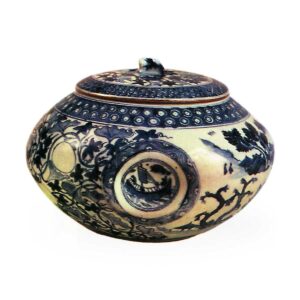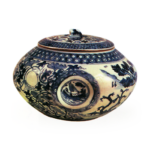
Jingdezhen is one of the largest kilns in China, located in Fuiliang County, Raoju Province, Jiangxi Province.
It is well known that this kiln has played a fundamental role in the history of Chinese ceramics since the Song dynasty (960-1279), with a variety of porcelain styles including blue-and-white, blue-and-white, underglaze red, and wucai (five-color glaze). According to historical records, the origin of this pottery dates back to the Han dynasty, but this is uncertain. In the Tang dynasty, it became known as the Changnanzhen kiln (named after its location south of the Chang River), and is said to have produced white porcelain and celadon. After the war, a Chinese survey revealed two kilns, Yang Meiting and Shihuwan, as kiln sites, but the details are unknown except that they produced Yuezhou-style celadon and near-white porcelain. The name “Jingdezhen” is derived from the fact that this area produced vessels during the Jingde period of the Northern Song dynasty (1004-7), and these vessels are the type of blue and white porcelain known as “shadow blue. These vessels were made of pure white porcelain clay covered with a transparent blue-white glaze with a slight iron reduction. They produced all kinds of vessels, including bottles, jars, water jars, incense burners, bowls, bowls, and plates, and were so widely produced that they were exported not only to the Far East, but also to Southeast Asia, the Orient, and the Mediterranean Sea. After the Southern Song dynasty (960-1279), blue-and-white porcelain was thickly made and the patterns were somewhat broken, and the porcelain industry seemed to have declined and gone into decline. This is probably due to the fact that the Longquan kilns in the same region took the initiative in trade by producing beautiful celadon called qunqin celadon, and that the two official kilns of the Southern Song produced celadon with extremely subtle glaze colors. In the Yuan dynasty, however, Jingdezhen once again began to flourish, producing white porcelain with a soft, milky-white glaze. The patterns on the surface, such as mold-printing, are in line with the Song dynasty, but it seems as if they were conscious of the gentle expression of the thick glaze covering them. There are known examples of white porcelain bowls of this type with molded cardinal inscriptions, but these are Yuan dynasty vessels and were probably the finest of their time. Eventually, Jingdezhen potters developed blue-and-white porcelain with underglaze cobalt or copper oxide designs, which became a major trend in the history of Chinese ceramics.








